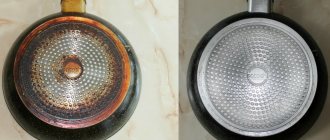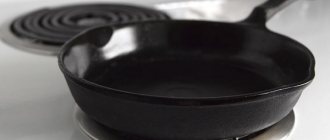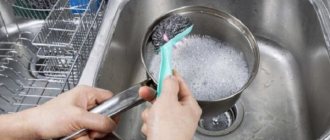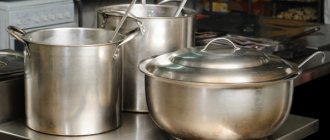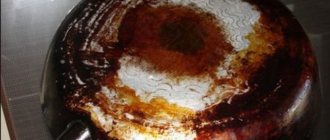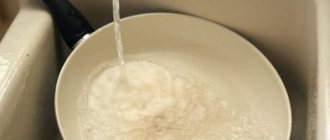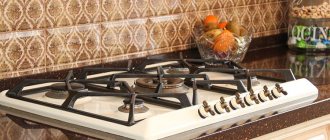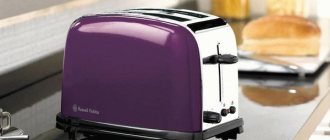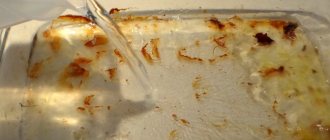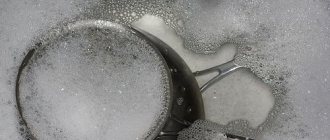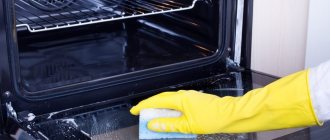Housewives value aluminum cookware for its light weight, corrosion resistance and good thermal conductivity. The new frying pan, despite its simplicity, looks impressive due to the shine of the metal, but after several uses the appearance deteriorates due to soot. Knowing some secrets, you can clean an aluminum frying pan from carbon deposits at home.
Soot on the frying pan.
What is important to know about aluminum frying pans
Aluminum cookware is made from special high-quality food-grade aluminum alloys and is characterized by environmental friendliness, durability, long service life, and relatively low price. Aluminum is a relatively soft metal, so it easily reacts with aggressive cleaning agents and is damaged by abrasives.
Aluminum cookware is made with and without various types of coatings. An uncoated pan is quite easy to clean compared to its non-stick counterparts. Aluminum frying pans have an unpleasant property: often, when overheated, their bottoms can become deformed.
The disadvantages of uncoated frying pans also include food burning during cooking, which causes the appearance of soot. Otherwise, if you do not take into account the shortcomings and adhere to basic rules during operation, such utensils will become an indispensable assistant in the kitchen.
How to clean a Teflon frying pan using household chemicals
Cleaning powders are not suitable for washing dishes with a non-stick layer - they scratch the surface, damaging the valuable coating. Liquids with abrasive inclusions, for example, so-called creams, are also not suitable for this.
Liquid detergents are ideal for washing grease and fumes from Teflon:
- without aggressive components (alkalis and salts);
- without abrasive additives;
- not intended for cleaning a wide range of surfaces, such as floors and tiles;
- without pungent odors (the surface on which food is prepared can absorb it).
There are many types and brands of detergents on store shelves. We offer a selection of household chemicals that are suitable for washing Teflon dishes:
- Synergetic – a natural product without harsh fragrances;
- Amway Dish - innovative composition and biodegradable formula;
- “Eared nanny” - designed for washing children’s dishes, but is capable of gently washing off carbon deposits;
- “Antinagar” – softens carbon deposits and does not injure the surface;
- Unicum Bami GOLD series – quickly removes dirt, does not require physical effort.
Causes of pollution
During cooking, the frying pan becomes dirty inside and out. Contaminants include burnt fat used in cooking and the food itself. Carbon deposits on the outside most often form from the heating elements of cooking surfaces. The pan gets the heaviest contamination when cooking on a gas stove.
Excess carbon and soot on the walls and bottom negatively affects not only the cooking process, but also its quality. It can be quite difficult to clean a frying pan from old carbon deposits, so it is recommended to carry out a general “washing” of aluminum cookware every month.
Cleaning: Basic Rules
Today, frying pans with ceramic coatings are real sales leaders. The high demand for cookware is due to its excellent non-stick properties, making the cooking process easy and fast.
Food does not stick to the surface, and food can be fried with a minimum amount of oil. Thanks to this, dishes retain the maximum amount of useful elements.
But to ensure the longevity of your cookware, you need to take proper care of it. For cleaning, it is recommended to use high-quality detergents that do not contain aggressive components.
If, after cooking pancakes, there is carbon residue on the surface, you can use several effective and simple methods. The fastest option is to use rubbing alcohol.
Dip a piece of cotton wool in the liquid and then wipe the contaminated areas with it. Then, the surface is rinsed with clean water.
Another effective and simple way is to use a melamine resin sponge. The cleaning process consists of the following steps:
- a small piece of sponge is moistened in water;
- thoroughly clean the sides;
- Wipe the base of the pan with a sponge.
After 15 minutes, even the most severe dirt disappears from the surface. But cleaning must be done carefully, since when pressed, the sponge can scratch the ceramic surface.
Methods for cleaning old carbon deposits from an aluminum frying pan at home
Simply washing the frying pan after use will not help avoid the formation of soot: a regular detergent cannot deal with this kind of contamination. Therefore, in the struggle for shine and purity, you will have to resort to very specific and even unusual methods.
There are many ways to get rid of carbon deposits, they depend on the degree of contamination. In any case, there is one that you like and will help you clean your favorite pans and put them in order.
Removing light carbon deposits
Light carbon deposits appear on the inner surface of the pan even after the first cooking. Therefore, to avoid severe contamination, it is recommended to clean pans immediately after use. Such measures will not require significant labor costs.
Removing light carbon deposits.
To combat small deposits, you can try cleaning the dishes using one of the suggested methods:
- It is necessary to mix a solution of soapy hot water and a few drops of ammonia. Wash the pan in the resulting liquid with a soft cloth. After the pan has been washed, you need to rinse it thoroughly under running water.
- A mixture of water and table vinegar in a 1:1 ratio will help deal with minor stains. It is enough to wipe the walls of the frying pan with a cotton swab dipped in the solution to remove dark deposits and light carbon deposits. After this, the pan must be rinsed thoroughly.
- You can clean small stains from burnt food by rubbing the surface with a slice of fresh apple.
Incandescent
Our grandmothers also used the incandescent method. Despite all the paradoxes, this method has proven to be the most effective.
In apartment buildings, it is difficult to clean a frying pan in this way, because during processing there will be a lot of smoke and unpleasant odors. But you can always find a more suitable option and clean the dishes, for example, by heating:
- In an open fire: place the frying pan in a fire, heat it well, then remove it from the fire and remove the soot layer using a scraper or spatula.
- With a blowtorch: after fire treatment, carbon deposits are removed without much effort.
- On the stove: the method is quite lengthy, more suitable for a gas stove (on an electric stove, such processing may be too expensive due to the high electricity consumption). The frying pan is placed on a burner turned on at maximum power and heated for at least two hours. Then remove the carbon deposits from the surface of the pan with a spatula. During the heating procedure, it is imperative to keep the windows open, as toxic substances begin to be released with strong heating.
Heating the pan on the stove.
Household chemicals
You can also clean aluminum cookware from carbon deposits using household chemicals. Newfangled special products for cleaning dishes, stoves or ovens can easily cope with even old carbon deposits. When applying the cleaning agent, you must use gloves, since any product contains caustic chemical elements.
Use household chemicals only according to the instructions. It is imperative to pay attention to the compatibility of the cleaning product with aluminum cookware. After processing, you must thoroughly rinse the pan.
Cleaners.
Mechanical cleaning
You can clean an aluminum frying pan from carbon deposits mechanically using certain tools. The following mechanisms are used for this:
- sandblasting machine: the frying pan is placed in a special chamber where it is blasted with sand under pressure. Such equipment can be found at the nearest car service and body repair station;
- A sander or drill with a special sanding attachment can also help clean aluminum cookware. When removing carbon deposits with tools, it is necessary to ensure eye protection from accidental contact with flying fragments. Cleaning work is best done in the fresh air, outside the home.
Mini sandblasting machine.
Grandmother's liquid method
Our grandmothers did not have grinding machines or modern household chemicals on hand to clean their kitchen utensils. But they somehow coped with even the most severe soot. They just knew a reliable recipe for a product that helped clean aluminum pans. To prepare “grandmother’s” remedy you need the following ingredients:
- 10 liters of water;
- 500 g soda ash;
- 200 g silicate glue;
- a piece of ordinary laundry soap.
Preparing the cleaning solution:
- Pour water into a large wide saucepan or basin and heat it.
- While the water is heating up, rub laundry soap on a grater.
- Grated soap, soda and glue are added to the pan and mixed thoroughly until the soap shavings are completely dissolved.
- After the mixture boils, lower a dirty frying pan into the container and boil it for about 1.5-2 hours. During this time, the carbon deposits soften greatly and are easily separated from the walls of the pan.
- Take the frying pan out of the container and clean it using a not very stiff brush.
Laundry soap solution.
After all procedures, the frying pan is thoroughly washed and wiped dry.
Soap and soda solution
The method is similar to “grandmother’s”, only silicate glue is not added to the solution:
- Water is poured into a large saucepan, sodium carbonate (soda ash) and soap shavings are added.
- Everything is brought to a boil.
- Lower the frying pan into the solution for 1.5-2 hours.
- Then you need to clean the surface with a brush and rinse the pan thoroughly.
Soap and soda solution.
Boiling in soda solution
You need a container that will fit the entire contaminated aluminum frying pan:
- Pour water into a saucepan or basin in such an amount that the pan is completely covered with liquid.
- For every liter of water you need to take 1 tbsp. a spoonful of soda ash.
- Place a frying pan in a container with boiling liquid and boil it for 10 minutes.
- Turn off the stove and leave everything for half an hour.
- After processing, you can clean the pan with a sponge or soft brush.
Boiling in soda solution.
Laundry soap with soda and glue
The method is suitable for cleaning the internal surface:
- Water is poured into a dirty aluminum frying pan up to the middle of the side.
- Add 2 tbsp. spoons of soap shavings, baking soda and 2 tbsp. spoons of PVA glue.
- Mix thoroughly until the laundry soap is completely dissolved.
- The solution is heated and boiled for 30 minutes.
- Allow the solution to cool, then wash off the plaque from the inner surface with a sponge and rinse thoroughly.
Real laundry soap.
Vinegar solution
The inner surface of an aluminum frying pan can be cleaned in the following way:
- Sprinkle 100 g of table salt in a thin layer on the bottom of the frying pan.
- Salt is poured with 250 g of table vinegar.
- The frying pan is placed on the burner and heated.
- When the liquid boils, add 2 tbsp. spoons of soda and leave on the stove until the liquid has completely boiled away.
- Carbon deposits are removed with a sponge or soft brush and the surface is washed with running water.
Table vinegar.
Lemon solution
This method allows you to clean both the inside and outside of the pan. To clean the inside, boil water in a frying pan for 5 minutes with the addition of 1 teaspoon of citric acid powder. Cool and wash as usual.
To clean the frying pan completely, pour enough water into a large bowl, pour citric acid into it at the rate of 1 teaspoon for each liter of water and boil the frying pan for half an hour. Then let it cool and wash.
Food grade citric acid.
Activated carbon
Activated carbon is most often used to clean steel cookware, but you can also try to clean the inner surface of aluminum cookware if the contamination is light:
- Powder from ground activated carbon tablets is poured onto the bottom of the frying pan, moistened with water and distributed evenly over the entire surface.
- Leave to act for 20-30 minutes.
- Then simply wash it off.
Coal in tablets.
Ammonia and borax
- 200 g warm water;
- 10 g sodium tetraborate;
- ammonia.
Mix water with borax and add a few drops of ammonia. Using a cotton swab or soft cloth, apply the composition to the inner surface of the frying pan and leave for 15-20 minutes, then simply rinse.
Ammonia solution.
Sunflower oil and washing powder
Pour water into a large saucepan or basin, add a little washing powder and pour 4 tbsp. spoons of sunflower oil. The frying pan is lowered into the resulting solution and boiled for 20 minutes. Then wash with regular detergent.
Sunflower oil for cooking.
Method from the USSR
This is another name for the “grandmother’s” method, which was written about above.
Cleaning solution using the USSR method.
Coca Cola
The drink, popular among young people, has firmly established itself in the list of available means that help clean an aluminum frying pan from carbon deposits and copes well with the task. To clean the inner surface, Coca-Cola is poured into a vessel and boiled for 30 minutes. To completely clean the dishes, pour the drink into a wide container and boil the entire frying pan in it.
Carbonated drink Coca-Cola.
Hydrogen peroxide and soda
Mix a slurry of soda and hydrogen peroxide, distribute it evenly on the surface of the frying pan and leave to act for 10-15 minutes. All that remains is to clean the dishes with a brush and rinse with water.
Three percent hydrogen peroxide.
Features of cleaning pans made of different materials
Before cleaning a frying pan, you need to understand which product and tool are suitable for this material.
There may be several options:
- Cast iron. It is an alloy of iron and carbon, heavy, durable and wear-resistant. It is not afraid of either abrasive or aggressive chemicals. It holds heat well for several hours, but takes a long time to warm up.
- Aluminum. This material, like the previous one, is budget material. However, aluminum has very different properties from cast iron: it is light, has a beautiful appearance, heats up quickly, but does not withstand long-term cooking at temperatures above 300°C and is deformed.
- Teflon. It is very convenient to use and easy to clean. In such a frying pan you can cook food without oil, which allows you to keep the calorie content of the dish low. Cleaning the non-stick coating is quite easy: you just need to gently rub the surface with a sponge and dishwashing liquid, and even burnt-on food will come off easily. But it is prohibited to use metal forks, spoons and spatulas - they scratch the protective layer.
- Ceramics. This is another type of non-stick coating. Compared to Teflon, ceramics are more environmentally friendly, resistant to high temperatures and mechanical damage. But it has its drawbacks: sudden changes in temperature damage the protective layer, acids and abrasives also negatively affect it.
Activated carbon
Activated carbon, found in the medicine cabinet of almost every home, is a fairly strong surfactant that can clean carbon deposits. Charcoal tablets are a cheap analogue of household chemicals.
To clean, you need to pre-soak the pan for 2-3 hours. Then pour in 10 powdered charcoal tablets and add about 150 ml of water. Place over high heat, bring to a boil and remove from heat. Wait until the charcoal solution in water cools down and wash it in the usual way.
Salt + vinegar + soda
To clean a burnt frying pan, you need to take all the active ingredients in a 1:1:1 ratio. Distribute the resulting mixture evenly over the entire surface of the product and leave for half an hour to an hour. Then use a stiff brush to remove any loose fat.
Restoring the protective layer on an aluminum frying pan after removing carbon deposits
At the end of the process of cleaning the aluminum frying pan from carbon deposits, you should try to restore the protective layer of aluminum so that the food does not burn during cooking. The recovery procedure is simple:
- Apply a layer of vegetable oil to the bottom and walls of the frying pan;
- keep the vessel in the oven at a temperature of 180-200 degrees for 1 hour;
- Turn off the oven and let the pan inside cool.
After the protective layer has been restored, you can use cleaned dishes only after a few days.
The process of cleaning a frying pan.
Preventing carbon deposits
In order for kitchen utensils to serve for a long time and not become covered with soot, several rules are followed. The frying pan is not heated to a temperature above 230°C. After such a thermal shock, the dishes will not only become covered with carbon deposits, but will also lose their protective Teflon layer.
Do not heat dishes without oil or leave them on the fire unattended. In the first case, the dishes are deformed and may even catch fire; in the second, the food will burn. Do not put too many foods into the dishes, especially fatty meats. If the layer is higher than the sides of the pan, the fat will flow down the outer walls.
baking powder
Housewives use baking powder to get rid of burning inside Teflon-coated dishes. Algorithm of actions:
- pour a packet of baking powder into the container;
- liquid is poured;
- the utensils are placed on the fire;
- the solution is brought to a boil.
After 15 minutes, pour out the liquid and rinse the pan with water using a sponge. The method is gentle, suitable for removing light plaque and soot.
Recommendations for caring for an aluminum frying pan
By following simple rules for caring for aluminum cookware, you can significantly extend its service life:
- When buying a new aluminum frying pan, you need to heat the table salt on it for about 15 minutes over medium heat. This will help create a protective layer that will prevent food from burning. After calcination, you can use the frying pan only after two days.
- Do not wash the aluminum frying pan in the dishwasher or use abrasive substances for cleaning.
- It is forbidden to store cooked food in a frying pan; it is necessary to transfer the food to another container.
